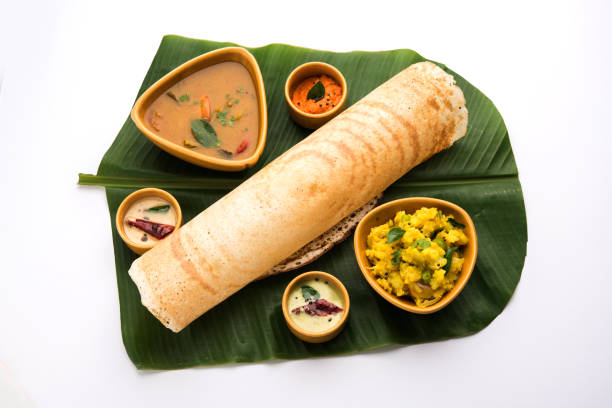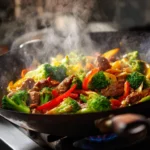Masala Dosa: The South Indian Culinary Delight
Introduction: Masala Dosa, an iconic dish from South India, has transcended regional borders to become a beloved staple in Indian cuisine. This crispy, golden-brown crepe, filled with a spiced potato mixture, is not just a meal; it’s a cultural phenomenon that has captured the hearts and taste buds of food enthusiasts globally. In this exploration, we’ll unravel the history, ingredients, preparation, and cultural significance of Masala Dosa.
Origins and History: The South Indian Culinary Heritage Masala Dosa finds its roots in the southern states of India, particularly in Karnataka. This beloved dish emerged as a staple breakfast item but quickly gained popularity across the country and beyond. The word “dosa” itself means “lump” or “portion,” reflecting the dish’s early preparation method, where the batter was ladled onto a hot griddle.
Ingredients: A Symphony of Flavors and Textures Masala Dosa is a deceptively simple dish that relies on a few key ingredients to create a harmonious combination of flavors and textures.
- Dosa Batter: The foundation of Masala Dosa is the dosa batter, made from a mixture of fermented rice and urad dal (black gram). This batter undergoes a fermentation process, contributing to the characteristic tangy flavor and the light, airy texture of the dosa.
- Potato Filling (Masala): The spiced potato filling, known as “masala,” is a mixture of mashed potatoes seasoned with mustard seeds, curry leaves, turmeric, onions, and sometimes green chilies. This filling adds a savory and aromatic element to the dosa.
- Coconut Chutney: Masala Dosa is often served with coconut chutney, a condiment made from grated coconut, green chilies, and other spices. The cool and slightly sweet chutney provides a delightful contrast to the warmth and spice of the dosa.
- Sambar: Another classic accompaniment is sambar, a lentil-based vegetable stew with tamarind, spices, and a medley of vegetables. The tangy and flavorful sambar enhances the overall dining experience.
- Ghee: Ghee, or clarified butter, is sometimes used to smear on the dosa, adding richness and a subtle nutty flavor.
Preparation: Crafting the Perfect Dosa The preparation of Masala Dosa involves several steps, each contributing to the creation of this delectable South Indian dish.
- Dosa Batter Fermentation: The dosa batter is made by soaking rice and urad dal, grinding them into a smooth paste, and allowing the mixture to ferment. This fermentation process can take several hours or overnight, resulting in a batter with a tangy flavor and aeration.
- Preparing the Potato Filling: The spiced potato filling, or masala, is prepared separately. Potatoes are boiled, mashed, and then sautéed with mustard seeds, curry leaves, turmeric, onions, and other spices. This filling becomes the heart of the Masala Dosa.
- Dosa Cooking: A ladleful of the fermented dosa batter is spread thinly on a hot griddle, creating a large, thin crepe. The dosa is cooked until it becomes golden brown and crisp on the edges. The process requires skill and precision to achieve the right balance of crispy and soft textures.
- Filling and Folding: The spiced potato filling is placed in the center of the dosa. The dosa is then folded over the filling, creating a cylindrical shape. Some variations include folding the dosa into a triangular shape or serving it flat.
- Serving with Accompaniments: Masala Dosa is traditionally served with coconut chutney and sambar on the side. The dosa is often accompanied by a dollop of ghee for added richness.
Cultural Significance: A Culinary Tradition and Social Ritual Masala Dosa is more than just a breakfast item; it’s a cultural symbol that reflects the vibrant culinary heritage of South India.
- Breakfast Tradition: In South India, Masala Dosa is a quintessential breakfast dish. It is served in homes, roadside eateries, and upscale restaurants alike, becoming a symbol of South Indian hospitality.
- Street Food Delight: Masala Dosa has also found its place as a popular street food item. Street vendors expertly prepare dosas on large griddles, adding to the lively street food culture in cities like Bangalore and Chennai.
- Social Rituals: Sharing a Masala Dosa with family or friends is a social ritual in many South Indian households. The communal act of tearing a piece of dosa and dipping it into chutney or sambar fosters a sense of togetherness.
Variations and Regional Twists: A Diverse Dosa Landscape While the classic Masala Dosa remains a favorite, regional variations and innovations have added diversity to the world of dosas.
- Mysore Masala Dosa: Originating from the city of Mysore, this variant features a spicier red chutney spread on the dosa before adding the potato filling, giving it a distinct flavor and color.
- Rava Dosa: Rava Dosa is made with a batter that includes semolina (rava) and rice flour. This dosa has a unique texture—thin and crispy with a lacy appearance.
- Paper Dosa: Paper Dosa is an ultra-thin version that’s larger in size, resembling a thin sheet. It’s often served folded or rolled and is prized for its delicate texture.
Pairing Suggestions: Creating a Flavorful Ensemble Masala Dosa is traditionally paired with accompaniments that enhance its flavors and textures.
- Coconut Chutney: A classic coconut chutney made with grated coconut, green chilies, and spices provides a cool and slightly sweet contrast to the warmth and spice of the dosa.
- Sambar: A bowl of tangy and flavorful sambar, made with lentils and an assortment of vegetables, complements the dosa, adding richness and depth to the meal.
- Gun Powder (Idli Podi): Some enjoy Masala Dosa with gunpowder, also known as idli podi, a dry spice mix made with roasted lentils and chilies. It adds a delightful kick to each bite.
Conclusion: Masala Dosa: A Culinary Tradition Unfolded Masala Dosa is more than just a dish; it’s a cultural tradition, a culinary craft, and a sensory experience that resonates with people around the world. Its journey from South Indian kitchens to global menus is a testament to its universal appeal. As we savor the crispiness of the dosa, the warmth of the spiced potato filling, and the array of accompanying flavors, we partake in a culinary tradition that spans generations. Masala Dosa, with its simplicity and depth of flavors, continues to be a cherished part of the rich tapestry of Indian cuisine—a timeless and iconic dish that transcends borders and brings people together over the joy of shared meals.












